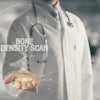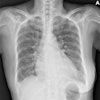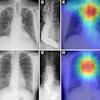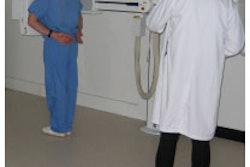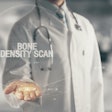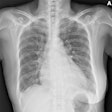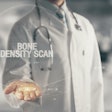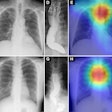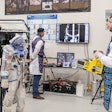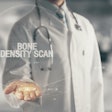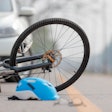BURLINGAME, CA - There's more to bone strength than its name would imply, and future measurement techniques will take a more holistic approach to bone health, according to a presentation last week at the California Society of Radiologic Technologists (CSRT) meeting.
"There's a brand-new definition for osteoporosis … it's a systemic skeletal disorder characterized by compromised bone strength (putting people) at an increased risk for fracture," explained physicist John Shepherd, Ph.D. "We're moving the field toward diagnosing based on fracture risk instead of bone density alone."
The main contributors to bone strength are density, bone turnover, bone architecture, and bone mineral, added Shepherd, who is an assistant professor in residence at the University of California, San Francisco (UCSF). And while a great deal of attention is currently being paid to these contributing factors, bone densitometry is in no danger of being toppled as the main imaging modality in this area.
"BMD (bone mineral density) alone, just the simple measurement that one would make of putting a bone on a scale and weighing the mass, predicts about 70% in vivo of the strength of that bone," Shepherd pointed out. "If you excised the bone and put it into a tension device that measured the strength that way, you would find that it measured about 80% of the strength. A lot of the field is focusing on architecture and other aspects, but it's interesting to note that those are so highly coupled to the way that bone forms in the body that a simple measurement of bone density can tell you virtually 70% of the story."
In his talk, Shepherd outlined quality assurance (QA) concepts for bone densitometry centers, highlighted improved imaging techniques, and introduced some of the new modalities currently under investigation.
Concepts in QA
For a center that plans to build a bone densitometry program, the following elements are crucial: the right physician to read the exams, the right densitometry device, and the right radiology technologist (RT) to perform the exams.
Although any physician can read a DEXA exam, it is preferable to have one who is specifically trained in the field and is certified by the International Society for Clinical Bone Densitometry (ISCD), Shepherd said.
No certification is required for RTs, but again Shepherd recommended that a person become a certified densitometry technologist (CDT). Non-RTs can also be granted limited licenses to perform DEXA exams.
Once a bone densitometry machine has been purchased, the manufacturer must report to the Food and Drug Administration that it has sold a machine. The facility must then report ownership of the DEXA scanner to the state, and certify that the program is being supervised by a doctor. Finally, signs regarding training and radiation warning must be posted.
The RT is then responsible for measuring the precision of the machine. Unfortunately, current devices don't make that task very simple.
According to an upcoming World Health Organization mandate, bone density measurements in the femoral neck should be the only criteria used for osteoporosis evaluation, Shepherd said. Other bone sites should be used to assess fracture risk and to decide who is at high risk.
"The key is to only make diagnosis on one measurement site," he said. "Some of the concepts that I wanted to (discuss) are quality assurance and how measurements can be taken with high quality."
Shepherd said that the biggest dilemma faced by those in bone densitometry is trying to compare measurements from one individual on different machines. This mix of old and new exams may be because a patient has relocated or changed healthcare providers. On the other hand, a facility may have bought new machines or changed staff.
"All you want to do is take the old exam and the new exam and tell if you've lost bone or gained bone," he said. "That really can't be done at all right now. The comparability of measurements between two densitometers that have no cross-calibration relationship is no better than 10%."
This is where precision comes in to the picture, both of the scanner and the RT. The precision of a bone densitometry unit is very specific to the machine and the technology, Shepherd said. The default precision values are set on the machines but these are never correct for individual sites.
For a single site with one machine and one RT, achieving precision is not as difficult, he said. The "least significant change" is what needs to be quantified between the baseline and the follow-up measurements.
For sites with multidevice machines and many RTs performing exams, achieving precision is more complex. Some of the issues that can seriously affect precision measurements are varying levels of experience and skill among technologists for positioning and analysis, whether patients can be scanned on the same machine every visit, and cross calibration between machines.
"In general, the guidelines are that if you have more than one DEXA system and more than one technologist, each technologist needs to scan 30 subjects twice to find out what their precision is and make sure that they're meeting the minimum standards of performance," Shepherd said. "If the systems are different makes and models, then you need to include a precision sample from each of those makes and models to give you an average site precision." Buying new machines or employing new RTs will mean starting all over and taking new precision measurements, he added.
New technology and techniques
"If you know about (the bone densitometry) field, you know that a lot of the systems have a single row of detectors. They are moving toward multirow systems, very similar to what you see in CT," Shepherd said.
Some of the technical improvements that can already been seen are improved resolution (0.5 mm versus 1 mm), automated analysis of bone sites instead of manual analysis, 0.5% precision compared with 1% precision, automated error checks versus manual/visual, and generating a fracture risk assessment in addition to the standard T-score.
"A T-score is just a way of normalizing a bone density value to a reference," Shepherd said. "That's moving toward a fracture risk assessment which says, 'If your 10-year fracture risk is over 10%, then you have osteoporosis.' That's something that we'll see in the field over the next few years."
Other technological advancements include vertebral morphometry, which looks at the vertebral bodies and the spine. "What has been a new trend is to do these lateral plain-film views with a bone densitometer. Instead of having 400 mSv of dose you have 30 mSv of dose. So the standard baseline notation is moving toward having a hip and spine density assessment to see if there is low bone density, and then looking for vertebral fractures as well in a quick scan on the same machine."
Vertebral fractures, or fragility fractures, are becoming more and more important in bone health assessment, Shepherd stressed. As bone density decreases, the relative risk of fracture increases substantially. But even in people with high bone density, the presence of even one fragility fracture can see their risk for another fracture increase dramatically, he said.
Femur morphometry also offers similar predictive measurements. "These measurements include the hip-axis length, the diameter of the midsection of the femur neck, and the cross-sectional moment of inertia. We can take these measurements together and come up with a model of strength just based on the mechanics of existing force," Shepherd said. "What was found was that every 10 mm increase in the hip-axis length doubled the risk of hip fracture."
New frontiers
The future of bone densitometry will focus more on bone architecture, particularly microarchitecture. Other areas of interest include the effects of drug therapy and other treatments of building and maintaining bone.
"Why do drugs that only put on a small amount of bone density bring about a large decrease in fracture risk? To look at that, we are looking at the microstructure of the bone," Shepherd said.
This microscopic assessment will be integral to developing a new scoring system based on densitometry results. The trabecular bone score (TBS) offers 14 different measurements including bone connectivity and volume.
Peripheral microCT and peripheral QCT may come into use to gauge TBS in vertebral bodies. These in vivo modalities would take high-resolution images at the feet and wrists using as little as 3 mSv of radiation.
Experimental work is also being done with synchrotron radiation, which can assess how porous bone is. Finally, 1.5- and 3-tesla MRI would offer 3D information or could be employed for virtual bone biopsy.
Whether these technologies will become part of clinical protocol remains to be seen, Shepherd said. At his institution, access to MRI and CT equipment is limited as trauma cases always take precedence, he said.
"We don't have people saying, 'ER! ER! We need a DEXA scan!'" he joked. "That just doesn't happen."
Shepherd encouraged CSRT participants to seek out work by Dr. John Kanis and colleagues for information on the variables, besides BMD, that factor into fracture risk including age, family history, and smoking (Osteoporosis International, June 2005, Vol. 16:6, pp. 581-589; Bone, November 2004, Vol. 35:5, pp. 1029-1037).
By Shalmali Pal
AuntMinnie.com staff writer
November 11, 2005
Related Reading
Osteoporosis screening, therapy very cost-effective for older women, November 7, 2005
MR study exposes physiologic differences in aging bone, October 20, 2005
Copyright © 2005 AuntMinnie.com
